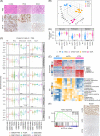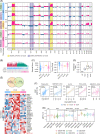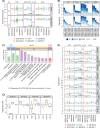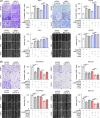Transcriptomic profiling of intermediate cell carcinoma of the liver
- PMID: 39101773
- PMCID: PMC11299988
- DOI: 10.1097/HC9.0000000000000505
Transcriptomic profiling of intermediate cell carcinoma of the liver
Abstract
Background: Intermediate cell carcinoma (Int-CA) is a rare and enigmatic primary liver cancer characterized by uniform tumor cells exhibiting mixed features of both HCC and intrahepatic cholangiocarcinoma. Despite the unique pathological features of int-CA, its molecular characteristics remain unclear yet.
Methods: RNA sequencing and whole genome sequencing profiling were performed on int-CA tumors and compared with those of HCC and intrahepatic cholangiocarcinoma.
Results: Int-CAs unveiled a distinct and intermediate transcriptomic feature that is strikingly different from both HCC and intrahepatic cholangiocarcinoma. The marked abundance of splicing events leading to intron retention emerged as a signature feature of int-CA, along with a prominent expression of Notch signaling. Further exploration revealed that METTL16 was suppressed within int-CA, showing a DNA copy number-dependent transcriptional deregulation. Notably, experimental investigations confirmed that METTL16 suppression facilitated invasive tumor characteristics through the activation of the Notch signaling cascade.
Conclusions: Our results provide a molecular landscape of int-CA featured by METTL16 suppression and frequent intron retention events, which may play pivotal roles in the acquisition of the aggressive phenotype of Int-CA.
Copyright © 2024 The Author(s). Published by Wolters Kluwer Health, Inc. on behalf of the American Association for the Study of Liver Diseases.
Conflict of interest statement
The authors have no conflicts to report.
Figures





References
-
- Joseph NM, Tsokos CG, Umetsu SE, Shain AH, Kelley RK, Onodera C, et al. . Genomic profiling of combined hepatocellular-cholangiocarcinoma reveals similar genetics to hepatocellular carcinoma. J Pathol. 2019;248:164–178. - PubMed
-
- Kim H, Park C, Han KH, Choi J, Kim YB, Kim JK, et al. . Primary liver carcinoma of intermediate (hepatocyte-cholangiocyte) phenotype. J Hepatol. 2004;40:298–304. - PubMed
-
- Beaufrère A, Calderaro J, Paradis V. Combined hepatocellular-cholangiocarcinoma: An update. J Hepatol. 2021;74:1212–1224. - PubMed
Publication types
MeSH terms
Substances
LinkOut - more resources
Full Text Sources
Medical
Molecular Biology Databases

